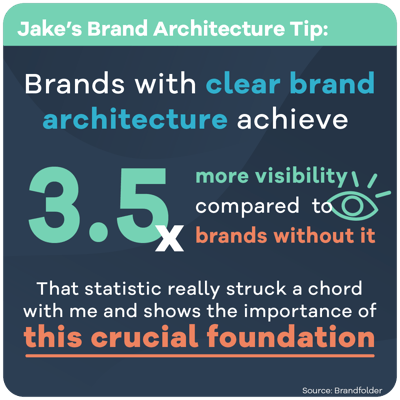In the ever-evolving world of marketing, understanding the intricacies of brand development and management is the key to standing out in a crowded market. While developing businesses over the years, I have become deeply involved in the process of branding. Branding is truly an art and science, a meticulous process of sculpting a unique identity for your company, products, or services.
Brand Architecture: Building the Foundation
When I think about brand architecture, I see it as the foundational blueprint for any prosperous brand. It's essentially the structural backbone of your brand portfolio, determining how all your different brands, sub-brands, and product lines interconnect.
Jake’s Brand Architecture Tip: According to a study by Brandfolder, brands with clear brand architecture achieve 3.5 times more visibility compared to brands without it. That statistic really struck a chord with me and shows the importance of this crucial foundation.

3 Primary Types of Brand Architecture
Now, speaking of brand architecture, there are three primary types, each with its unique merits
Monolithic Branding: This approach involves using a single brand name across all products or services. Think of Apple, where the Apple brand is applied to everything from iPhones to MacBooks. This approach creates a strong, unified brand image.
Endorsed Branding: In this model, a parent brand endorses or supports various sub-brands or product lines. For example, Google endorses products like Google Maps and Google Drive, providing a sense of credibility and trust to these offerings.
House of Brands: House of Brands architecture involves managing multiple independent brands under a larger corporate umbrella. A classic example is Procter & Gamble (P&G), which owns a vast portfolio of brands, including Crest, Tide, and Pampers, each with its unique identity.
Clarity and Consistency: The Bedrock of Branding
Consistency is the linchpin of successful branding.
Jake’s Brand Consistency Tip: A study by Lucidpress revealed that consistent brand presentation can increase revenue by up to 23%. Develop branding and style guidelines to ensure teams are using consistent branding across your marketing and advertising assets.

To achieve consistency, your brand messaging should be clear and cohesive across all touchpoints, from your website and social media to your packaging and customer service interactions.
Effective brand messaging should convey your brand's core values, mission, and unique selling propositions. It should resonate with your target audience and create a lasting impression. Consistency in messaging builds trust and recognition, making it easier for customers to identify and connect with your brand.
Managing Sub-Brands: Striking the Right Balance
Many companies operate sub-brands within their portfolio, catering to different market segments or customer preferences. However, managing these sub-brands can be a delicate balancing act.
Consider brands like Walmart and Gap, which own a mix of value brands and luxury brands. To maintain a clear distinction, it's often advisable to keep these sub-brands entirely separate in the eyes of customers and employees. This separation prevents confusion and dilution of each brand's identity.
Gap and Old Navy are owned by the same parent company, but customers don't necessarily need to know this. Keeping them distinct helps avoid potential conflicts and ensures each brand can thrive independently.
A Strategic Approach to Brand Evolution
In the world of branding, evolving or refreshing your brand is both an art and a science. It requires a deep understanding of brand architecture, a commitment to clarity and consistency, and a strategic approach to managing sub-brands.
As you navigate the complexities of brand development and management, remember that each decision you make impacts your brand's perception and success. By carefully crafting your brand architecture and ensuring clarity and consistency in your messaging, you can create a strong, lasting brand that resonates with your target audience and stands the test of time.
.png?width=56&height=56&name=Jake-01%20(1).png)



